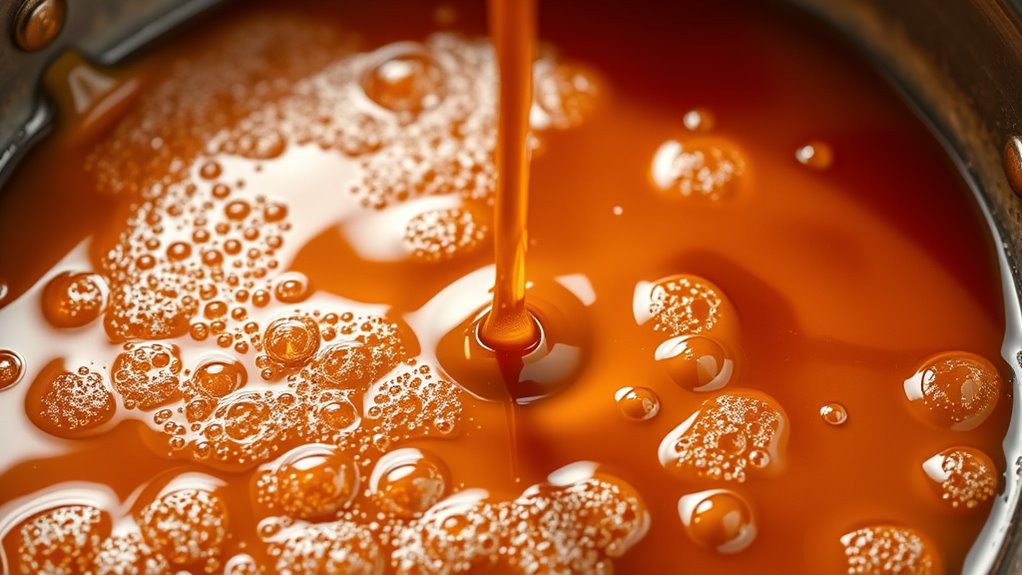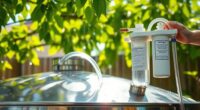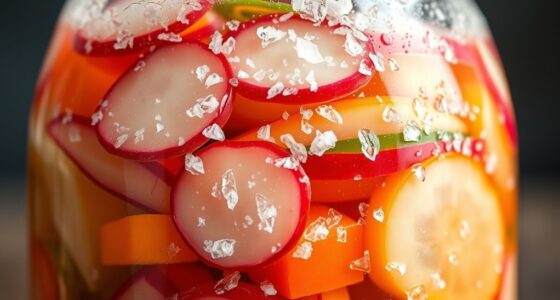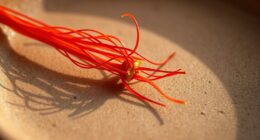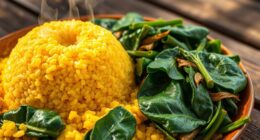As you heat sugar, it first melts into a clear syrup around 320°F, then begins to break down through complex reactions. You’ll see it turn amber as caramelans, caramelens, and caramelins form, creating the characteristic color and flavor. Controlling temperature is key—too high, and it burns; too low, it stays light. Volatile aroma compounds develop, giving caramel its distinctive scent. If you keep exploring, you’ll discover how these stages create the rich, layered flavors you love.
Key Takeaways
- Heating sugar causes it to melt into a viscous liquid and undergo complex chemical breakdown reactions.
- Temperatures around 320°F (160°C) initiate caramelization, producing caramelans, caramelens, and caramelins that develop flavor and color.
- During caramelization, new aroma compounds form, releasing volatile molecules with nutty, toasty, and sweet notes.
- Precise temperature control ensures even caramelization, preventing scorching and achieving desired color and flavor.
- Additional reactions, like the Maillard process, may influence flavor but are secondary to sugar transformations in pure caramel.
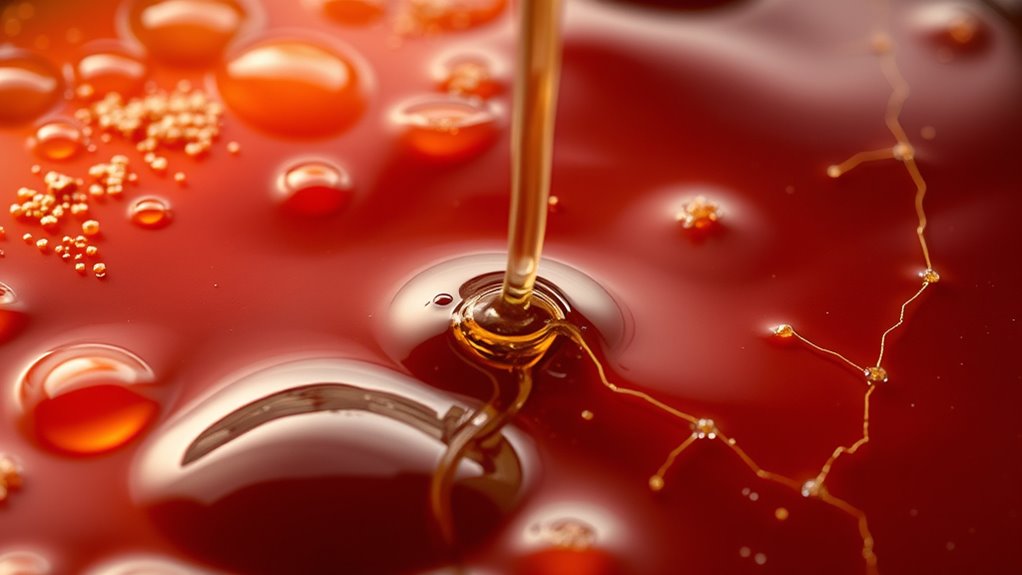
Have you ever wondered what gives caramel its rich, complex flavor? It all comes down to the fascinating chemistry happening as sugar transforms during cooking. When you heat sugar, two main processes occur: the Maillard reaction and the caramelization process. While both contribute to flavor development, caramelization is the primary pathway responsible for that signature golden-brown hue and deep, sweet taste we associate with caramel.
The caramelization process begins when the heat causes the sugar molecules to break down. As temperature rises, the sucrose molecules first melt, turning into a clear, viscous liquid. Once the temperature hits around 320°F (160°C), the real magic starts. The sugar molecules start to decompose through a series of complex reactions, producing a variety of new compounds. These include caramelans, caramelens, and caramelins—all responsible for the characteristic flavor and color. The process is highly sensitive to temperature and time; too little heat and the sugar remains light and sweet, too much and it burns, turning bitter and acrid.
During caramelization, the sugar undergoes chemical changes that produce not only color but also aroma compounds that give caramel its distinctive scent. As these reactions proceed, new molecules form, releasing volatile compounds that carry sweet, nutty, and toasty notes. This transformation is a gradual process, and controlling the heat is vital to achieve the desired flavor profile without burning the sugar. Stirring and monitoring temperature guarantee an even caramelization, preventing hotspots that could cause uneven coloring or scorching. Precise temperature control is essential for consistent results and optimal flavor development.
Additionally, understanding the stage‑by‑stage transformations involved in caramelization enables bakers and chefs to better control the final flavor and appearance of their confections. Recognizing the chemical reactions that occur during each stage allows for more precise timing and temperature adjustments, leading to consistent results. Knowing how the temperature influences each phase helps in achieving the perfect caramel every time. The Maillard reaction, often confused with caramelization, also plays a role when proteins and sugars are present, such as in milk or butter. It involves the reaction between amino acids and reducing sugars, creating complex flavors and browning. While it’s more prominent in baked goods and roasted foods, it can subtly influence the flavor of caramel, especially when dairy is involved. However, in pure caramel making, the caramelization process is the dominant factor shaping flavor and color.
Understanding these stage‑by‑stage transformations helps you master the art of making perfect caramel. By paying attention to temperature, timing, and ingredients, you control the chemical reactions that produce that luscious, rich flavor you love. Whether you’re drizzling it over desserts or using it in candies, knowing the chemistry behind caramel allows you to craft the perfect finish every time.
Frequently Asked Questions
How Does Humidity Affect Caramelization?
Humidity impact plays a significant role in caramelization. When moisture effects are high due to increased humidity, it can slow down the caramelization process by preventing sugar from reaching the necessary high temperatures. You might notice that your caramel becomes sticky or doesn’t develop that rich color. To get consistent results, keep an eye on humidity levels and consider adjusting your cooking time or environment to minimize moisture effects.
Can Caramelization Occur Without Heating?
Caramelization is like a fiery dance, but it can’t truly happen without heat. Without heating, sugar crystallization might occur, but the rich caramel aroma development stays out of reach. You won’t see the deep golden color or complex flavor notes without applying heat. So, while sugar can melt or crystallize naturally, the transformative magic of caramelization demands temperature, turning simple sugar into that irresistible, aroma-filled treat.
What Are the Health Effects of Caramel Compounds?
Caramel health concerns mainly stem from caramel compound toxicity, which can occur if you consume excess caramelized products. Some caramel compounds may contain chemicals linked to health issues, especially if heated improperly or processed with additives. While moderate consumption is generally safe, overindulging could pose risks. Always check product labels and avoid artificial caramel colorings if you’re concerned about caramel compound toxicity or potential negative health effects.
How Does Different Sugar Types Influence Caramel Flavor?
Different sugar types distinctly determine caramel’s flavor development by shaping the sugar structure and influencing taste. For example, glucose offers a clean, sweet note, while sucrose produces richer, more complex flavors upon caramelization. Fructose, being more reactive, leads to faster, deeper caramel notes. You’ll notice that choosing specific sugars allows you to craft unique flavors, as each sugar’s structure uniquely steers the caramel’s scent and taste sensations.
Can Caramel Be Reversed or Undone Once Formed?
Caramel stability is limited, and once it forms, reversing it isn’t straightforward. Generally, caramel cannot be undone or fully reversed because the chemical reactions, like Maillard reactions and sugar polymerization, are mostly irreversible. Reversal possibilities are minimal; you might dilute or cool it to halt further changes, but the caramel’s flavor and structure remain. So, you should aim for precise timing to prevent over-cooking rather than trying to reverse caramel once it’s made.
Conclusion
As you watch the sugar darken to a rich, amber hue, you witness a magical transformation unfold. The sweet crystals melt into a bubbling, golden syrup, releasing a warm, inviting aroma that beckons your senses. With each stage, the simple sugar evolves into a complex tapestry of flavors and colors, like a painter’s brushstroke on a canvas. This journey from sweetness to caramel reveals the enthralling chemistry that turns ordinary ingredients into a delicious masterpiece.
